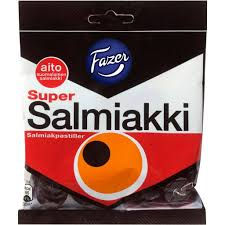Salmiakki
- csalmela
- Sep 14, 2020
- 5 min read

Flavors are a window into the soul of a culture. Curry and saffron on the Indian subcontinent. Ginger and garlic in China. Miso and Wasabi in Japan. Oregano and basil in the Mediterranean. Parsley, chives, and thyme on the European continent. What we eat is kind of who we are. It tells us how we appreciate the things that sustain us.
For Finland, nothing conjures up the taste imagination of a nation like salmiakki. It is Finland’s most uniquely-loved, notorious flavor. And for the record, it is absolutely horrible. Think vegemite is an abomination? Finland's got one up on that, admittedly, not by much. This blog isn’t objective, so within these confines, salmiakki is officially a hideous flavor. And for this blog post, I guarantee you I will get lambasted by many a Finn. I may not get my residence card from this, so I hope you're appreciating my candor.

Let’s start with what Salmiakki actually is. For those who don’t want the embarrassment of poor Finnish pronunciation, it is simply salty licorice. You could probably just ask for salty licorice at any candy store or R Kioski in Finland and you’d get pretty much the right thing. As far as taste goes, even Finnish pronunciation does it justice: SAHL-mee-YAHK-kee—as in Salmi-YUCKY.
Licorice alone is a challenging flavor, and just to show I’m not only a good sport here but actually gracious, I really like black licorice. And Finland makes great black licorice! Maybe the best.
Panda licorice is based 6km from where I type this out. It has a solid following in America and around the world. A soft, rich, molasses-y, full-bodied, black licorice, Panda is a licorice icon and for good cause. It’s delectable.
It’s most common forms are little bite-sized tube chunks that come in a black box with yellow “Panda” on the front and they used to have a Panda bear on it but not sure that’s the case anymore. That’s how anyone who’s probably had Panda licorice has been introduced to it. Also a fave are the individually-wrapped solid sticks that are super satisfying to chew into. Santa Claus brought me those almost every year in my stocking—further proof that Santa is from Finland. Sinking teeth into a Panda stick is a sensory must. Today, Panda licorices come in all sorts of varieties. One of the coolest is the bite-sized tubes filled with different flavors in the tubes—coco, banana, strawberry just to name a few.
Panda has been with everyone in our family, most of our lives. Mimmu's childhood home is just up the road and her grandma used to work in the factory. You can still smell the sweetness driving through Vaajakoski when the wind blows just right. I’ve been eating it since the ‘70s when the health foods store across from Red Owl grocery in the Thunderbird Mall in Virginia, MN, started selling it when I was just a wee lad. It was the only thing from that store that I ever actually liked to eat. My kids have spent every summer going to the Panda factory outlet to bring goodies back to friends and family in the States. Why Finland couldn’t just stop with Panda will be one of the great mysteries of Finland for me. But it didn’t. Salmiakki took it an ill-advised step further.
Wikipedia describes salmiakki as "Salty liquorice, salmiak liquorice or salmiac liquorice; a variety of liquorice flavoured with the ingredient "salmiak salt" (sal ammoniac; ammonium chloride), and is a common confectionery found in the Nordic countries, Benelux, and northern Germany." Notice the “ammonia” and “ammonium chloride.” Those are key.
Take a chunk of soiled cat litter, add a ton of salt and anise and a pinch of sugar, stick that in the back of your throat, and I think you have the gist.
As Parkinson’s has taken some of my nuance of smell and taste, particularly at the front of the tongue, I am even more acutely aware of how a food’s flavor lingers at the back of the throat where the air from the nasal passages interacts with the taste sensors on the back of the tongue. Salmiakki is an after-taste tour de force. I believe it is completely possible that salmiakki’s offense to me personally is to do with how the ammonium chloride takes hold in the back of the throat while and immediately after eating it. And it doesn’t just take hold. It takes a death grip.

I have to believe the attraction and enjoyment of salmiakki must be genetic as much as cultural. I know a lot of people related to me who love it. Equally if not more people hate it though. The best thing about salmiakki is watching for the reaction from anyone who hasn’t had it before. It’s a total crap shoot, but surprisingly, a lot of people will raise their eyebrows and say, “interesting” and keep eating the piece they were given. I’ve never seen a grown non-Finnish adult eat their first piece of salmiakki and absolutely love it. I’m sure they exist, but even the “not-bad”ers have to be part of the genetic freakdom, that’s how bad it is. But for everyone else, first attempts most often end with that look around for the hidden camera because surely this is a practical joke.

Salmiakki comes in different shades of offensive. Fazer makes a great fruity candy called Ässä mix. Which is great! The best-tasting fruity chewy candies in the world, mixed with black diamonds that taste like Äss. No false advertising. Luckily, Mimmu likes the Äss-flavored diamonds, so it’s a perfect marriage. Those diamonds though, are tame ones.
You can get salmiakki that is truly, truly offensive; stuff that crosses your eyes as the ammonia gas seeps up through your nostrils and flushes your tear glands. That’s for the tough people. Steer clear.
In most countries famous for glorious summers, you’d order a nice ice cream bar covered in a hard, silky-smooth layer of milk chocolate. Makes sense. But in Finland, the ice cream delicacy is a stick with perfectly delicious vanilla ice cream covered in a hard, black veneer of cat piss flavoring. Or worse, a black, frozen block of it. You can even get salmiakki syrup for your ice cream. Shake my head.
I’ve written a lot of nice stuff about Finland. Salmiakki might be the one thing, if any, that undoes Finland’s near-flawlessness. As a talker, I must simply gig the country on its resolute shyness as a cultural trait, I can’t avoid that. It’s probably the Karelian in me. I realize my effusiveness is the real offense over here and I’m thus forced to tone it down. Thankfully, I’m pretty shy in Finnish myself, so it evens out. But a close second to the cultural effectiveness of social distancing with or without covid, is salmiakki. That a country so put together on so many fronts can not only concoct this “candy” as something to be enjoyed but create a market for it, is a sign that certainly, nobody—or country—can possibly be perfect.










Comments